全文HTML
--> --> -->同轴枪强流脉冲放电有两种放电模式[14,15]: 预填充模式与爆燃模式. 预填充模式放电过程中, 首先在真空腔内充入一定量的气体, 之后对同轴枪两电极施加电压, 同轴枪底端击穿产生致密的等离子体, 等离子体在同轴枪的底端形成一个很薄的电流层, 在放电过程中两电极间径向电场和流过中心电极电流感应的角向磁场产生洛伦兹力, 电流层受到洛伦兹力的作用向前运动. 研究发现[15-18]: 尽管预填充模式放电等离子体有很多方面的应用, 但是其电流密度高、温度高, 很容易烧蚀电极使等离子体掺杂杂质, 而且预填充模式放电产生的电流柱等现象会产生磁流体不稳定性影响等离子体输运的准直性. 此外, 预填充模式产生的等离子体在向前运动过程中与中性气体发生碰撞, 也会降低等离子体的输运速度.
相比于预填充模式, 爆燃模式有着诸多优点, 该放电模式可以得到杂质更少、准直性更高、输运速度更快的等离子体射流[8,15,19,20]. 爆燃模式放电首先需要将真空腔室维持高真空10–3 Pa后通过电磁阀向同轴枪内部注入气体, 气体注入到同轴枪底端的同时对同轴枪的内外电极施加电压使其击穿产生等离子体, 等离子体受到洛伦兹力和热膨胀的作用向前运动. 等离子体射流向前运动时不会与中性气体发生碰撞, 相同条件下其喷射速度高于预填充模式放电. 爆燃模式放电过程中等离子体的温度相对较低, 对电极的烧蚀小, 掺杂的杂质少, 而且相对于预填充模式具有更好的准直性. 爆燃模式放电往往应用于空间推进等方面[15].
爆燃模式放电得到了广泛的重视并有很多研究, 墨西哥国立自治大学的Woodall和Len [14]研究了爆燃模式放电等离子体在枪内输运过程中的磁场分布, 表明爆燃模式放电下等离子体温度相对于预填充放电模式很低, 并且在放电过程中枪内布满了等离子体; 斯坦福大学的Poehlmann等[15,20,21]对于爆燃模式放电过程中枪内的电流分布等一系列参数进行了分析, 通过观察枪内电流的分布分析了等离子体在同轴枪内的速度特性; 德克萨斯大学奥斯汀分校的Subramaniam等[22]在Poehlmann的实验设备基础上, 使用数值模拟与实验结合的方法进一步研究了爆燃模式放电过程中的等离子体在输运过程中的密度分布与温度分布. 实验研究中发现, 进气量与放电电压是影响爆燃模式放电的重要参数, 对于喷射出的等离子体团形状、等离子体的输运速度和密度有着很大的影响, 而与其相关的研究很少.
本文实验研究通过调节电压和进气量来改变等离子体的特性, 对今后的实验和应用有一定的参考价值. 实验主要开展了爆燃模式放电等离子体的特性研究. 自主设计了延时触发器, 通过延时触发控制气体进入到同轴枪底端与给两电极施加电压的同时性, 使同轴枪放电为爆燃模式放电. 使用光电二极管、光谱仪、数码相机等设备对等离子体参数和形态进行诊断与分析, 针对进气量与放电电压的变化对爆燃模式下同轴枪放电等离子体参数的影响展开研究.
 图 1 实验装置原理图
图 1 实验装置原理图Figure1. Schematic diagram of experimental equipment
实验室自主设计可以调节时间间隔的延时触发器, 可以使气体到达同轴枪底端的同时触发火花开关, 进而给同轴枪的内外电极施加电压使底端的气体击穿产生等离子体. 延时触发器输出信号间隔时间0.1 ms到10 ms可调, 工作的脉宽时间0.1 ms到10 ms可调. 在同轴枪的底部设计了输入气体的进气孔, 将电磁阀连接到通气孔上控制进气量, 实验时打开电磁阀的时间为4 ms, 电磁阀进气端气压为0.1 MPa, 出气端通过进气孔连接到真空腔室, 气压10–3 Pa. 通过改变施加电磁阀的电压来改变电磁阀阀门的大小, 进而改变进气量. 实验之前对电磁阀施加不同电压观察真空腔室内气压的变化, 进而通过PV = nRT(P为气压、V为体积、n为粒子物质的量、R为气体常量、T为温度)计算出进气量的变化.
在放电回路中放入Pearson电流探头测量放电过程中的回路电流, 将电流探头连接到示波器, 使示波器上显示电流的信号波形. 将连接光谱仪的光纤探头的准直器放在距离同轴枪的出口5 cm, 靠近钢化玻璃输运通道的位置, 主要测量Hβ的谱线, 以便使用斯塔克展宽法计算出口处位置的电子密度. 通过磁探针与积分器可以探测实验过程中同轴枪放电电流产生的磁场大小, 对于磁场变化的观察可以分析在放电过程中电流的变化. 通过将两个磁探针分别放在同轴枪的底部和距离底部5 cm处, 磁探针可以探测环绕同轴枪内电极的角向磁场, 进而可以观察同轴枪底部是否有电流通道产生.
将两个连接光电探测器的准直器放置在与等离子体的输运方向平行的位置, 靠近同轴枪枪口处的钢化玻璃输运通道, 间距5 cm, 其中靠近同轴枪枪口的一端距离枪口2.5 cm, 用来收集等离子体通过同轴枪出口处的光信号. 当等离子体经过准直器的采集点时准直器能够采集到光信号, 并且等离子体光强度和准直器采集的光信号强度正相关. 通过光纤将准直器和光电探测器连接, 使准直器采集的光信号能够输入到光电探测器, 光电探测器可以将光信号转化为电信号输入到示波器, 用来观察等离子体的形态变化. 准直器可以减少采集到的发散光. 通过进入到两个准直器得到光信号第一个峰值的时间, 以及两个准直器的间隔距离可以计算出在同轴枪枪口喷出的等离子体的输运速度.
3.1.进气量的影响
将真空腔室气压稳定在10–3 Pa, 电容充电电压固定在5 kV后, 设置延时触发器, 使气体通过电磁阀进入同轴枪底端的瞬间, 打开火花开关对同轴枪施加电压, 即产生爆燃模式放电.图2(a)—(d)分别为充电电压5 kV时, 进气量1.4, 2.1, 2.3, 2.6 mg所对应的电流信号与光电流信号. 首先观察电流波形. 电流波形为一个不断衰减的正弦波, 说明打开火花开关后整个电路形成RLC回路, 且在放电过程中同轴枪内部一直存在电流通道. 不同进气量条件下第一个半周期电流基本不变, 为52 kA左右, 电流脉宽为50 μs左右. 这是因为等离子体的电阻和电感相对于回路很小, 在放电过程中对于回路几乎没有影响.
 图 2 (a)—(d)分别为电压为5 kV, 进气量为1.4, 2.1, 2.3, 2.6 mg的电流信号与光电流信号
图 2 (a)—(d)分别为电压为5 kV, 进气量为1.4, 2.1, 2.3, 2.6 mg的电流信号与光电流信号Figure2. Current and photocurrent signals for 5 kV voltage at gas in the coaxial gun bottom of (a) 1.4 mg, (b) 2.1 mg, (c) 2.3 mg and (d) 2.6 mg, respectively
图2中光信号1与光信号2是将两个连接光电探测器的准直器平行地放在同轴枪出口附近, 靠近钢化玻璃输运通道, 距离5 cm. 通过用两个准直器的间距5 cm除以两个光信号第一次达到峰值时的时间差, 可以计算出等离子体喷射的速度. 图3所示为充电电压5 kV、不同进气量时等离子体输运速度变化曲线. 当进气量1.4 mg时速度最高为27.9 km/s, 随着进气量的增加等离子体的输运速度逐渐降低, 当进气量增加到2.6 mg时, 输运速度为17.2 km/s. 这是由于在爆燃模式放电下, 随着进气量的增加, 更多的中性气体被电离成等离子体, 使得其质量在总体上有所增加, 进而使等离子体的输运速度降低.
 图 3 电压5 kV时等离子体输运速度随着进气量的变化
图 3 电压5 kV时等离子体输运速度随着进气量的变化Figure3. The velocity versus with the gas which enters in the coaxial gun bottom with the discharge voltage 5 kV
将光谱仪的光纤探头放在距离同轴枪枪口5 cm处, 在光纤探头的前端放入准直器减少采集到的发散光. 光谱仪曝光时间为3 s, 光栅设置为1200 g/mm, 测量Hβ的谱线, 用来计算等离子体的密度. 由于光谱仪的曝光时间为3 s, 所得到的Hβ谱线为时间累加所得, 所以得到的值为等离子体团密度最大位置处的密度, 这对于观察等离子体密度随着进气量和放电电压的变化趋势没有影响. 使用斯塔克展宽法测量同轴枪出口附近等离子体的密度, 这种方法是当电子密度在1014—1016 cm–3的范围时适用. 测量到的谱线如图4所示. 其中Hβ谱线为486.1 nm, 将Hβ谱线拟合, 其结果如图5所示, 其谱线展宽为0.089 nm. 此外, 由于Hβ谱线既有均匀展宽(洛伦兹展宽), 也有非均匀展宽(高斯展宽), 所以实验所得到的拟合谱线的展宽是由均匀展宽和非均匀展宽共同得到的总展宽(佛克脱展宽Δλv). 洛伦兹展宽、高斯展宽和佛克托展宽之间的关系为[2,23]
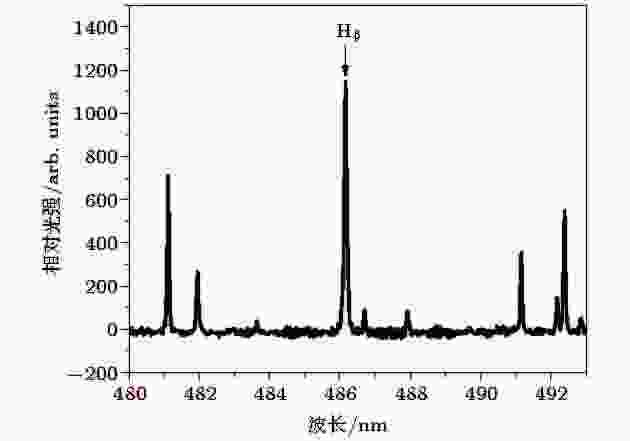 图 4 放电电压5 kV、进气量1.4 mg、光谱仪曝光时间3 s光栅设置为1200 g/mm时的Hβ谱线
图 4 放电电压5 kV、进气量1.4 mg、光谱仪曝光时间3 s光栅设置为1200 g/mm时的Hβ谱线Figure4. The Hβ line of the discharge voltage 5 kV, the gas which enters in the coaxial gun bottom 1.4 mg, the exposure time of the spectrometer 3 s, and the grating set at 1200 g/mm
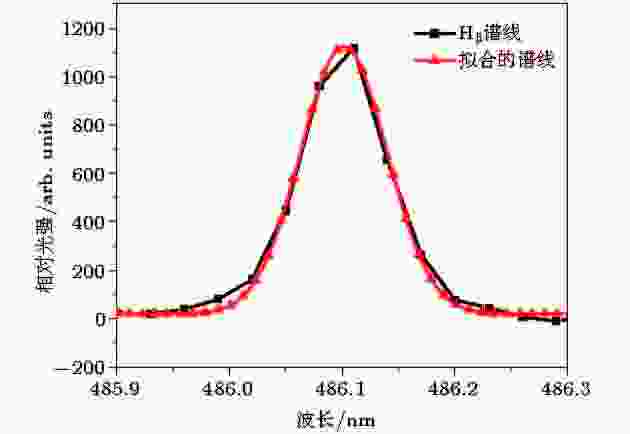 图 5 进气量1.4 mg、放电电压5 kV时, Hβ谱线及其拟合曲线, 展宽为0.089 nm
图 5 进气量1.4 mg、放电电压5 kV时, Hβ谱线及其拟合曲线, 展宽为0.089 nmFigure5. Hβ spectrum and its Lorenz fitting line, spectrum broadening is 0.089 nm
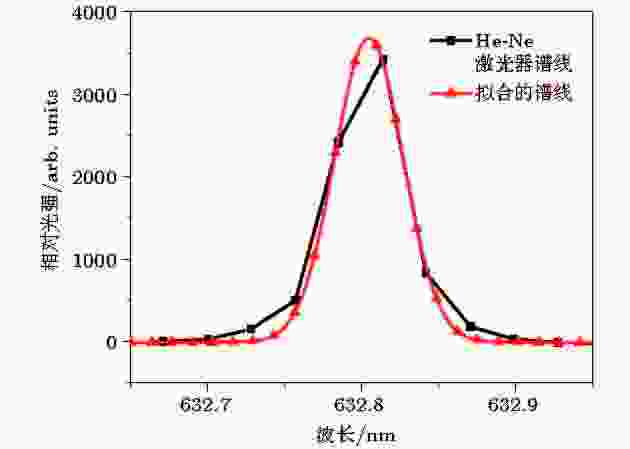 图 6 使用氦氖激光器测量得到的仪器展宽, 得到的展宽为0.036 nm
图 6 使用氦氖激光器测量得到的仪器展宽, 得到的展宽为0.036 nmFigure6. Instrument broadening measured using helium laser, spectrum broadening is 0.036 nm
在爆燃模式同轴枪放电的实验中, 中性氢原子的温度在2 eV左右, 通过(2)式计算得出多普勒展宽约为0.053 nm. 在实验中, Hβ的谱线展宽主要为洛伦兹展宽主导, 爆燃模式放电等离子体的中性气体温度相对于预填充模式较低, 一般的变化范围在几eV左右, 所以在变换进气量和电压参数的过程中, 温度在几eV的变化对于Stark展宽法计算电子密度影响很小, 对于分析等离子体密度变化趋势几乎没有影响. 高斯展宽、仪器展宽和多普勒展宽的关系为
佛克托展宽、Stark展宽和高斯展宽的关系为
图7为当放电电压5 kV不变时, 所测量的电子密度随着进气量的变化, 进气量从1.4 mg到2.6 mg. 从图7中可以看出, 随着进气量的增加, 电子密度增加, 当进气量为2.6 mg时, 等离子体数密度最大为2.0 × 1014/cm3. 这是由于增加放电时的进气量使更多的中性气体进入到同轴枪内发生电离, 产生了更多的等离子体, 进而导致电子密度随之增加.
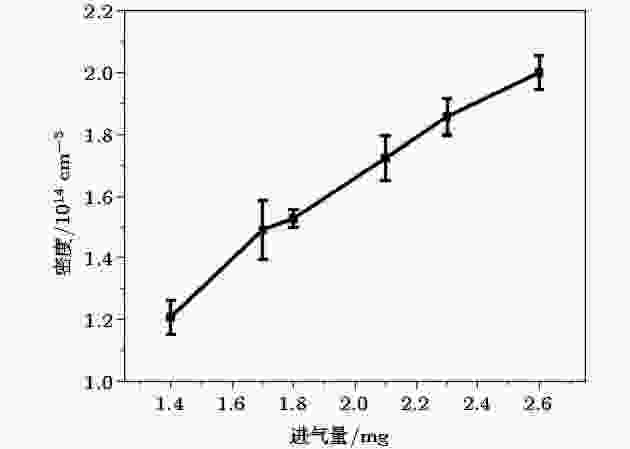 图 7 放电电压5 kV时电子密度随进气量变化
图 7 放电电压5 kV时电子密度随进气量变化Figure7. Electron density versus the gas with the discharge voltage of 5 kV
观察图2(a)的第一个半周期的光信号1波形发现, 在进气量较少的条件下, 光电探测器探测到了多个等离子体团发出的光, 说明在进气量1.4 mg时有多团等离子体从枪口喷出, 随着进气量的增加等离子体团数量减少, 如图2(b)和图2(c). 观察图2(d), 可以看出当进气量达到2.6 mg时, 只有一团等离子体从枪口喷出. 分析认为[15], 在爆燃模式放电条件下, 气体在同轴枪底部击穿, 在放电过程中会有部分等离子体残留在同轴枪的底端, 当还有气体从进气孔进入底部时, 同轴枪底部将继续击穿电离产生等离子体, 最终导致出现有多团等离子体从枪口喷出的现象. 而随着进气量的增加, 在放电过程中同轴枪底部加入了更多的中性气体, 使得难以形成新的电流通道, 最终只有一团等离子体从枪口喷出. 而在正半周期放电后同轴枪内有中性气体和残留的等离子体, 在负半周期放电过程中形成了图2所示的持续喷出的等离子体, 这一过程称之为爆炸模式(detonation mode)[15,22]. 爆炸模式放电在之后的研究中再做进一步的分析.
2
3.2.磁探针验证
为了验证多团等离子体从同轴枪枪口喷出是由于同轴枪底部再次产生电流通道, 即多次放电现象, 实验过程中使用两个磁探针分别放在同轴枪底部和距离底部5 cm处. 放在同轴枪底部的为磁探针1, 采集到的信号为磁信号1; 放在距离底部5 cm处的为磁探针2, 采集到的信号为磁信号2. 如图1原理图中所示.图8表示的是放电电压为5 kV, 进气量分别为1.4 mg和2.6 mg时, 放电过程中的电流信号和磁探针采集到的磁信号. 观察图8(a)第一个放电半周期可以发现, 磁信号2在有些时间点下降. 在放电过程中, 当同轴枪底部产生新的电流通道时, 流过磁探针2的电流减小, 使得磁探针2周围产生的磁场减小. 而观察图8(b)没有发现磁信号2下降的现象. 这说明在同轴枪底部确实有新的电流通道产生.
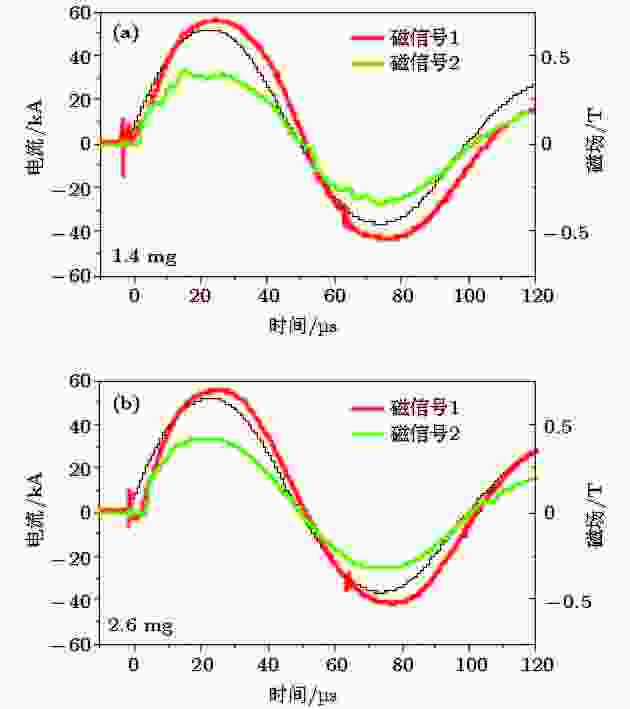 图 8 放电电压5 kV进气量分别为1.4 mg和2.6 mg条件下的电流信号和磁信号
图 8 放电电压5 kV进气量分别为1.4 mg和2.6 mg条件下的电流信号和磁信号Figure8. The current signal and magnetic signal for for 5 kV voltage at gas in the coaxial gun bottom of (a) 1.4 mg and (d) 2.6 mg, respectively
2
3.3.电压的影响
图9所示为进气量均为2.6 mg, 放电电压分别为5, 6, 7, 8 kV时的电流信号和光电流信号. 将两个连接光电探测器的准直器平行的放在同轴枪出口处, 钢化玻璃输运通道附近, 距离5 cm, 再通过观察两个信号的时间差可以计算出等离子体喷射的速度. 图 9 (a)—(d)分别为进气量2.6 mg, 电压为5, 6, 7, 8 kV的电流信号与光电流信号
图 9 (a)—(d)分别为进气量2.6 mg, 电压为5, 6, 7, 8 kV的电流信号与光电流信号Figure9. Current and photocurrent signals for 2.6 mg gas in the coaxial gun bottom at voltages of (a) 5 kV, (b) 6 kV, (c) 7 kV and (d) 8 kV, respectively
图10为进气量2.6 mg, 等离子体输运速度随电压的变化曲线. 从图10中可以看出, 随着电压的增加等离子体输运速度快速增加, 放电电压由5 kV升高到8 kV的过程中, 等离子体的输运速度由17.2 km/s升高到了41.7 km/s. 爆燃模式下等离子体通过J × B的洛伦兹力和热膨胀的共同作用向前输运. 当进气量一定的情况下, 随着电压的增加, 放电回路的电流逐渐增加, 等离子体所受的洛伦兹力增加, 等离子体的温度也会略微升高. 又由于在爆燃模式放电的条件下, 真空腔室内的气压很低, 等离子体在向前输运的过程中不会与中性粒子发生碰撞. 因此等离子体的输运速度会随着电压的增加而快速增加.
 图 10 进气量2.6 mg速度随着电压的变化
图 10 进气量2.6 mg速度随着电压的变化Figure10. The velocity versus discharge voltage with the gas which enters in the coaxial gun bottom of 2.6 mg
图11为进气量2.6 mg时, 利用Stark展宽法计算得出的等离子体密度随电压的变化曲线, 图中可以看出随着电压增加等离子体的密度增加, 放电电压8 kV时, 密度最大达到2.8 × 1014/cm3. 这是由于随着电压的升高, 有更多的中性粒子电离为等离子体, 使得等离子体的密度增加. 而当放电电压增加到一定程度, 同轴枪内的等离子体趋于完全电离时, 等离子体的密度趋于平缓.
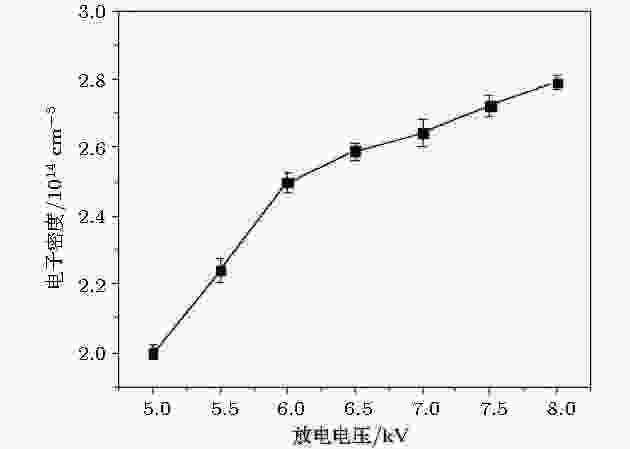 图 11 进气量2.6 mg时电子密度随着电压的变化
图 11 进气量2.6 mg时电子密度随着电压的变化Figure11. The electron density versus discharge voltage with the gas which enters in the coaxial gun bottom of 2.6 mg
从图9(a)中可以看出, 放电电压5 kV时, 只有一团等离子体从同轴枪的枪口喷出, 随着放电电压增加, 会有多团等离子体从枪口喷出. 这是因为爆燃模式放电过程中, 随着放电电压的增加, 在放电过程中回路电流增加. 当放电过程中有中性气体从进气孔进入到同轴枪的底端时, 同轴枪底端将会再次击穿电离中性气体, 产生的等离子体团从枪口喷出. 从而导致有几团等离子体从枪口喷出[15].
图12分别为电压5 kV和8 kV时使用数码相机拍摄的图片, 曝光时间为1 s. 从图中可以看出, 随着电压增加输运的距离有所增加. 说明放电电压增加使得等离子体的定向输运速度增加, 使得输运的距离也明显增加.
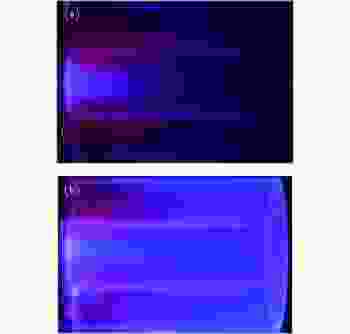 图 12 数码相机拍摄的同轴枪放电图片, (a), (b)分别为进气量5.5 mg, 电压为5 kV和8 kV时的图片
图 12 数码相机拍摄的同轴枪放电图片, (a), (b)分别为进气量5.5 mg, 电压为5 kV和8 kV时的图片Figure12. The coaxial gun discharge pictures taken by the digital camera, the exposure time is 1 s, with the gases which enter in the coaxial gun bottom of 5.5 mg and the discharge voltage of (a) 5 kV and (b) 8 kV respectively
2
3.4.电容的影响
为了进一步研究在爆燃模式下有多团等离子体从同轴枪枪口喷出的现象, 实验过程中通过改变放电回路中充电电容的大小, 分别调节电容的充电电压不变与电流不变来观察等离子体团的变化.图13(a)和图13(b)分别表示放电电压5 kV、进气量1.4 mg、充电电容180 μF和120 μF时的电流信号和光电流信号. 将图13与图2(a)表示的放电电压5 kV、进气量1.4 mg、充电电容240 μF时的电流信号和光信号进行对比. 实验中发现, 在相同放电电压和进气量条件下, 随着充电电容的减小, 多团等离子体从枪口喷出的现象在逐渐减弱. 可以在图2(a)、图12(a)和图12(b)中看出, 随着充电电容的减小, 回路电流的幅值和脉宽都减小, 使得在放电过程中很难在同轴枪底部再次形成电流通道, 所以同轴枪喷出多团等离子体的现象逐渐减弱.
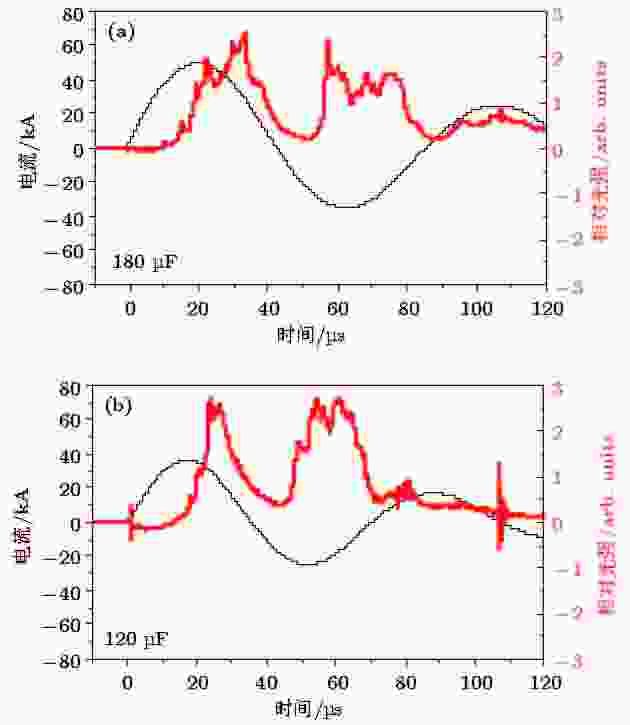 图 13 (a), (b)分别为放电电压5 kV、送气量1.4 mg、电容分别为180 μF和120 μF的电流信号和光电流信号
图 13 (a), (b)分别为放电电压5 kV、送气量1.4 mg、电容分别为180 μF和120 μF的电流信号和光电流信号Figure13. Current signals and photocurrent signals for a discharge voltage of 5 kV, 1.4 mg gas in the coaxial gun bottom, and capacitances of (a) 180 μF and (b) 120 μF, respectively
图14(a)和图14(b)是改变充电电容, 通过调节电压使得其与图2(a)的电流幅值相同, 进而可以比较在相同放电电流和进气量的情况下, 放电周期对于同轴枪喷出的多团等离子体的放电现象的影响. 实验中可以看出, 在相同回路电流和进气量的条件下, 随着充电电容的减小, 多团等离子体从枪口喷出的现象在逐渐减弱. 这说明充电电容的周期会影响多团等离子体从枪口喷出的程度. 具体原因需要之后的进一步分析.
 图 14 (a), (b)分别为电流幅值52 kA、送气量1.4 mg、电容分别为180 μF和120 μF的电流信号和光电流信号
图 14 (a), (b)分别为电流幅值52 kA、送气量1.4 mg、电容分别为180 μF和120 μF的电流信号和光电流信号Figure14. Current signal and photocurrent signal for current amplitude of 52 kA, 1.4 mg gas in the coaxial gun bottom, and capacitance of (a) 180 μF and (b) 120 μF, respectively
同轴枪放电过程中电流波形为一个衰减的正弦波, 说明同轴枪放电电路等效为一个RLC回路, 且在放电过程中同轴枪内部一直存在电流通道. 不同进气量条件下等离子体的密度不同, 但是第一个半周期电流峰值与周期基本不变. 这是因为等离子体的阻抗和感抗相对于回路很小, 在放电过程中对于回路整体的电阻和电感几乎没有影响.
在相同放电电压下, 进气量少时会有多团等离子体从枪口喷出, 随着进气量的增加同轴枪放电产生的等离子体密度增加, 输运速度减小, 在进气量2.6 mg时只有一团等离子体团从枪口喷出. 这是由于进气量增加, 会使得有更多的中性气体电离, 使得等离子体密度增加. 增加进气量使得等离子体的质量在总体上有所增加, 进而使等离子体的输运速度降低. 气体进入到同轴枪底部进行击穿, 当还有气体从底部进入时, 同轴枪底部的等离子体和中性气体会形成新的电流片向前运动, 导致有多团等离子体从枪口喷出. 而随着进气量的增加, 有可能导致进气量过多使的同轴枪底部很难形成新的电流通道, 最终只有一团等离子体从枪口喷出. 二次放电时, 真空腔室内有中性气体和残留的等离子体, 其放电模型是爆炸模式放电, 其放电特性需要之后的进一步分析.
在相同进气量下, 随着电压的增加等离子体密度增加, 输运速度增加, 速度最大为41.7 km/s, 开始出现有多个等离子体团从枪口喷出. 这是由于随着电压的升高, 有更多的中性粒子被电离为等离子体, 使得等离子体的密度增加. 而当放电电压增加到一定程度, 同轴枪内的等离子体趋于完全电离时, 等离子体的密度趋于平缓. 而电压增加使电流增加, 等离子体受到的洛伦兹力增加, 所以输运速度增加. 随着放电电压的升高, 在放电过程中电极两端的电压也升高. 当有中性气体从进气孔进入到同轴枪的底端时, 回路电流增加, 使得在同轴枪底端容易产生新的电流通道, 从而导致有几团等离子体从枪口喷出.
在相同放电电压和进气量条件下, 改变充电电容, 发现随着充电电容的减小, 多团等离子体从枪口中喷出的现象逐渐减弱. 这是由于随着充电电容的减小, 回路电流的幅值和脉宽都减小, 使得在放电过程中很难在同轴枪底部再次形成电流通道, 所以同轴枪喷出多团等离子体的现象逐渐减弱.
在相同放电电流和进气量条件下, 改变充电电容, 发现随着充电电容的减小, 多团等离子体从枪口喷出的现象在逐渐减弱. 这说明充电电容的周期会影响多团等离子体从枪口喷出的程度. 具体原因需要之后的进一步分析.
最后通过磁探针验证了在放电过程中同轴枪底部新电流通道的产生.
因此在之后做爆燃模式放电的研究和应用中, 可以通过调节电压、进气量和充电电容来调节等离子体的特性.
